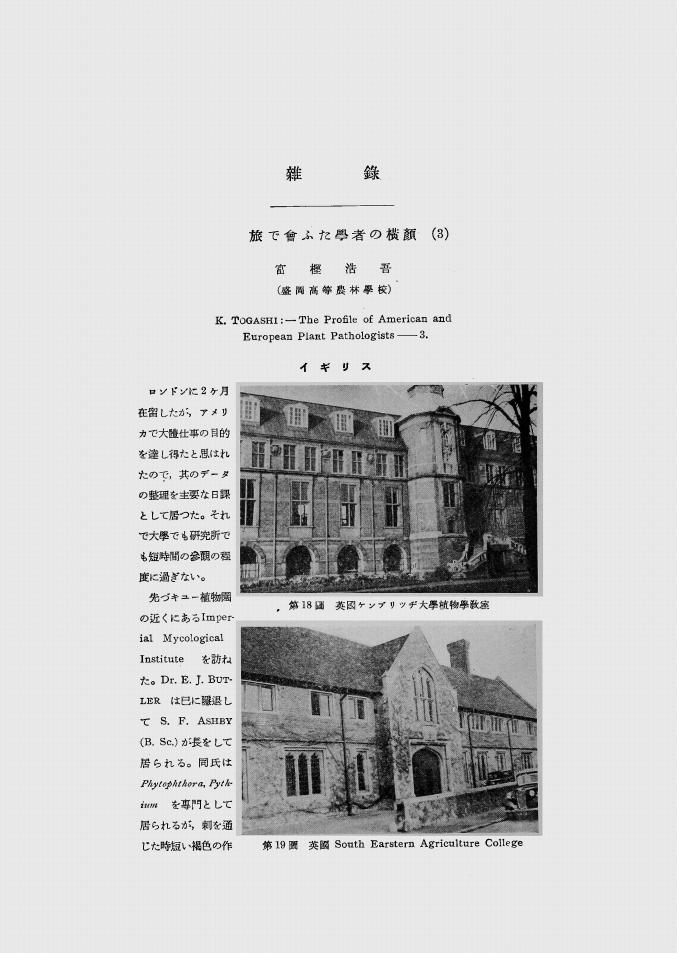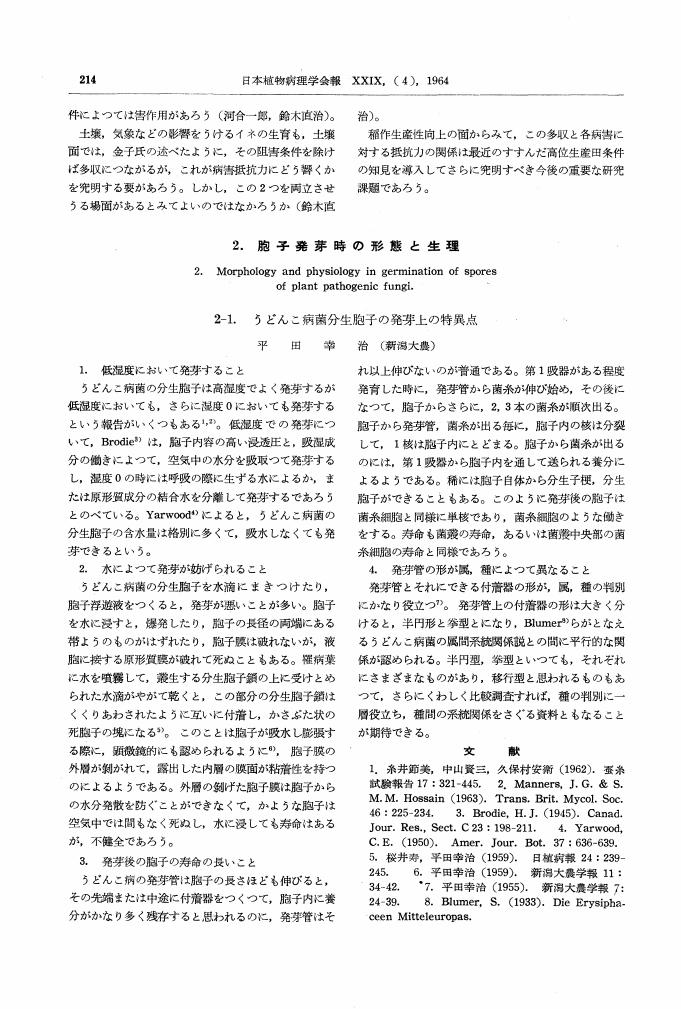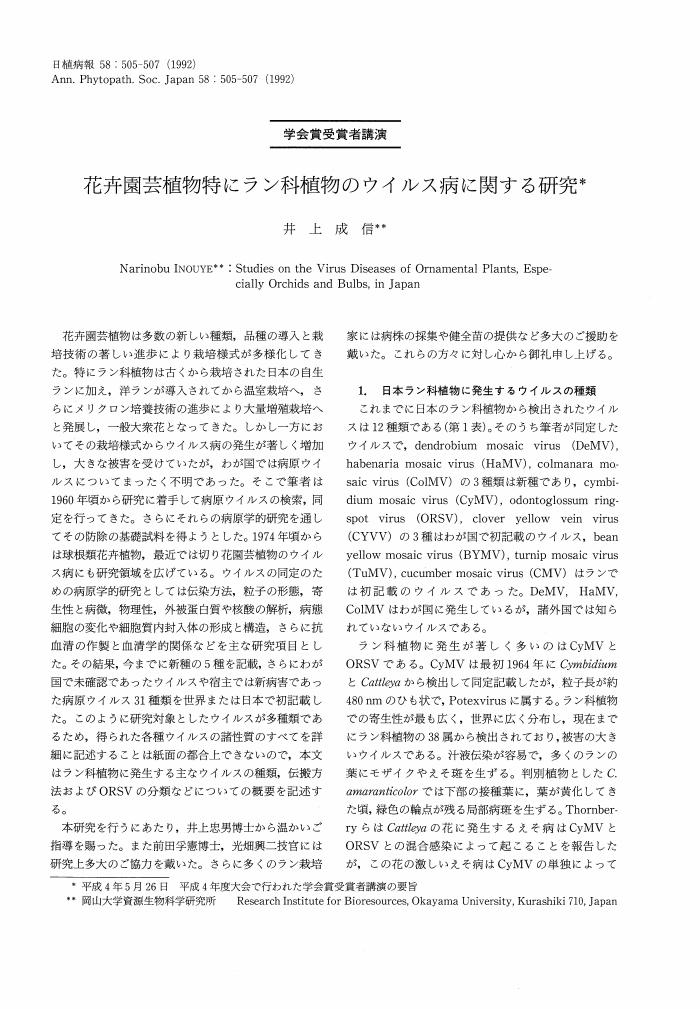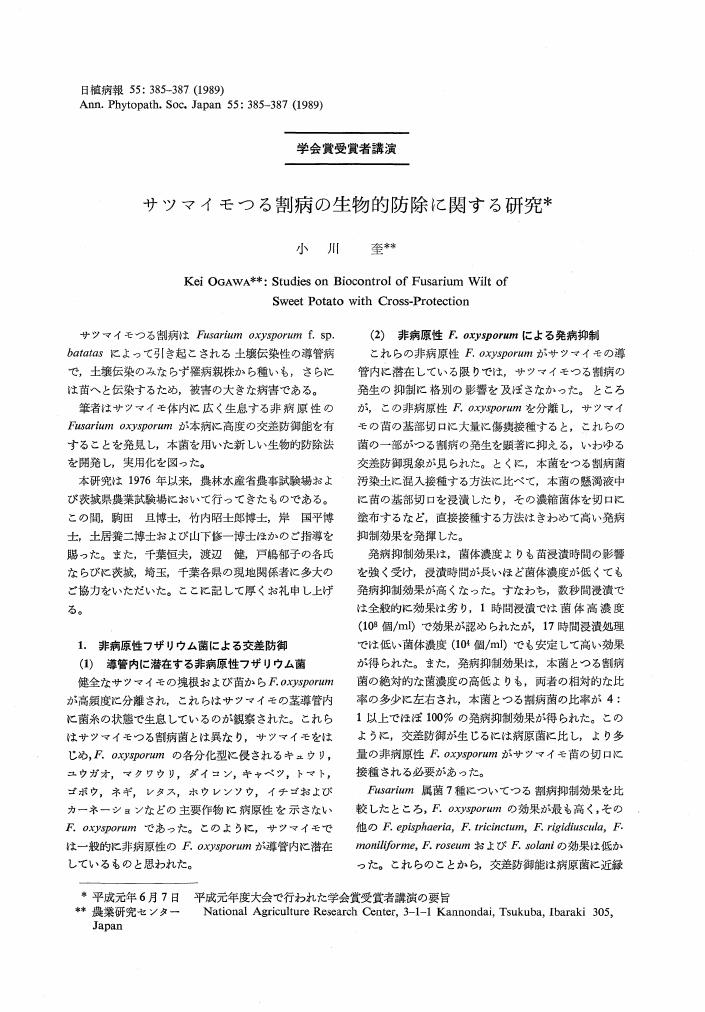115 0 0 0 OA 植物ウイルス病に関するもっとも古い記録とみられる万葉集の歌について
- 著者
- 井上 忠男 尾崎 武司
- 出版者
- The Phytopathological Society of Japan
- 雑誌
- 日本植物病理学会報 (ISSN:00319473)
- 巻号頁・発行日
- vol.46, no.1, pp.49-50, 1980-01-25 (Released:2009-02-19)
- 参考文献数
- 13
- 被引用文献数
- 17 22
Yellow vein of Eupatorium chinense var. simplicifolium caused by a geminivirus (Osaki and Inouye, 1979) had long been attracted attentions by some Japanese botanists and plant pathologists. A poem written by the Empress Koken on the yellow leaf of Eupatorium in the year of 752 that appeared in “Manyoshu” would be the first record in all over the world in the literature of the possible plant virus disease.
3 0 0 0 OA 旅で會ふた學者の横顏 (3)
- 著者
- 富樫 浩吾
- 出版者
- The Phytopathological Society of Japan
- 雑誌
- 日本植物病理学会報 (ISSN:00319473)
- 巻号頁・発行日
- vol.9, no.4, pp.236-242, 1939 (Released:2009-04-03)
2 0 0 0 OA 古代インドにおける植物病害と菌類について
- 著者
- 山本 昌木
- 出版者
- The Phytopathological Society of Japan
- 雑誌
- 日本植物病理学会報 (ISSN:00319473)
- 巻号頁・発行日
- vol.51, no.3, pp.249-251, 1985-07-25 (Released:2009-02-19)
- 著者
- 小室 康雄 岩木 満朗
- 出版者
- The Phytopathological Society of Japan
- 雑誌
- 日本植物病理学会報 (ISSN:00319473)
- 巻号頁・発行日
- vol.34, no.2, pp.98-102, 1968 (Released:2009-04-21)
- 参考文献数
- 10
- 被引用文献数
- 2 3
(1) わが国のトマトに発生の多いTMV-トマト系はタバコ(ブライトエロー)に局部病斑を作るだけで全身感染せず,トルコ種のXanthiに対してはTMV-普通系と同様,局部病斑を作らず全身感染する性質をもつている。製品たばこにこのTMV-トマト系がどの程度含まれているかを調査し,ひいてはトマトのモザイク病の伝染源になつているかどうかを推定しようと試みた。(2) まずわが国で栽培の多いといわれるタバコ7品種(ブライトエロー,だるま,遠州,ヒックス,桐ケ作,松川,水戸3号)に対しTMV-トマト系を接種し,それらタバコの反応を調べた。その結果,供試7品種はすべてその接種葉に局部病斑をつくるだけで全身感染しなかつた。一方,対照区として用いたTMV-普通系に対しては局部病斑はつくらず全身感染してモザイク症状を示した。(3) わが国で製造販売されている紙巻たばこ16種類,それぞれ20本についてまずTMVの検出を行ない,あわせてそのTMVの系統が普通系,トマト系のいずれに該当するかについて判別を行なつた。その結果,すべての紙巻たばこからTMVが検出された。その分離されたTMVの系統はすべて普通系と考えられるものであつた。11種類のたばこでは普通系のみが分離されたが,「ハイライト」,「こはく」,「ホープ」,「泉」,「エムエフ」の5種類からは普通系と重複してトマト系がある程度分離された。(4) 畑のトマトから分離されるTMVの大部分がTMV-トマト系であるという事実8)と,ここにあげた(2),(3)の結果とを併せ考えると,従来トマトのモザイク病の伝染源として製品たばこが重要な一つと考えられていたが,最近Broadbent2)が指摘しているように,わが国でもそれほど重要なものではないだろうと推論した。
2 0 0 0 瓜類露菌病菌の分化:(1).胡瓜及南瓜上の露菌病菌の病原性の比較
- 著者
- 岩田 吉人
- 出版者
- The Phytopathological Society of Japan
- 雑誌
- 日本植物病理学会報 (ISSN:00319473)
- 巻号頁・発行日
- vol.11, no.3, pp.101-113, 1941
- 被引用文献数
- 5
1. 圃場觀察に依れば南瓜露菌病の初期發生は胡瓜の其より相當期間後れるが胡瓜に露菌病の發生激甚なる時其に隣接せる南瓜畑に全く發病を認めなかつた。<br>2. 胡瓜の露菌病病斑は型的に角形を呈し,病斑の大さは材料により平均4.7×3.4mm又は5.3×3.7mmを示したに比し南瓜の露菌病病斑は平均1.6×1.0mmで遙かに小形である。<br>3. 胡瓜上の露菌病菌は接種方法に依り,殆んど或は全く南瓜を感染せしめざるに反し南瓜上の菌は胡瓜を感染せしめ病斑及分生胞子を形成した。又其他10餘種の栽培又は野生瓜類に對する兩菌の病原性を比較した所,兩菌は大體同様であつたが唯ゴキヅルに對し胡瓜上の菌は病原性を示し南瓜上の菌は陰性を示した。<br>4. 南瓜上の露菌病菌の分生胞子懸濁水を以て胡瓜,甜瓜,越瓜等に噴霧接種すると南瓜露菌病病斑と同様な小形の病斑を形成した。<br>5. 胡瓜上及南瓜上の露菌病菌は其病原性及病徴より異る生態種に屬するものと考へられる。<br>6. 自然状態に於て胡瓜には通常の角形病斑の他に南瓜露菌病病斑に似た小形の露菌病病斑を發生するが病斑上の分生胞子形成は稀少に過ぎない。之は恐らく南瓜上の露菌病菌が胡瓜に傳染したものと思はれる。
2 0 0 0 OA 植物増生病を引き起こすタフリナ属菌のインドール酢酸生合成
- 著者
- 山田 哲治 塚本 浩史 白石 友紀 野村 哲也 奥 八郎
- 出版者
- The Phytopathological Society of Japan
- 雑誌
- 日本植物病理学会報 (ISSN:00319473)
- 巻号頁・発行日
- vol.56, no.4, pp.532-540, 1990-10-25 (Released:2009-02-19)
- 参考文献数
- 19
- 被引用文献数
- 17 22
サクラてんぐ巣病菌(Taphrina wiesneri),モモ縮葉病菌(Taphrina deformans),スモモふくろみ病菌(Taphrina pruni)など,植物に増生病を引き起こすタフリナ属病原糸状菌はインドールピルビン酸(IPyA),インドールアセトアルデヒド(IAAld)を中間代謝物としてトリプトファン(Trp)からインドール酢酸(IAA)を合成する。これらの糸状菌はまた,インドールアセトニトリル(IAN)をIAAに転換する能力をもつ。IANをIAAに転換する酵素,IANニトリレースは基質誘導を受ける適応酵素であるが,TrpをIPyAに転換する酵素,Trpアミノトランスフェラーゼは基質によって誘導を受けない。
2 0 0 0 OA 2. 胞子発芽時の形態と生理
- 出版者
- The Phytopathological Society of Japan
- 雑誌
- 日本植物病理学会報 (ISSN:00319473)
- 巻号頁・発行日
- vol.29, no.4, pp.214-218, 1964-09-30 (Released:2009-02-19)
- 著者
- 岸 國平 古川 聡子 小林 享夫 白石 俊昌 酒井 宏 田中 一嘉
- 出版者
- The Phytopathological Society of Japan
- 雑誌
- 日本植物病理学会報 (ISSN:00319473)
- 巻号頁・発行日
- vol.64, no.1, pp.43-49, 1998
堀による命名以後,アナモルフの記載等に疑問を残したまま放置されてきたネギ黒渋病について研究し,以下のような事実を明らかにした。<br>(1)群馬県下仁田町で,多年にわたり自家採種と連作が繰り返されてきた同町特産の下仁田ネギに,本病が毎年激しく発生することが認められた。(2)本病の発生は下仁田町を含む関東北部,東北,北海道地域で多く認められ,関東南部および関東以西の地域ではまれにしか認められなかった。(3)培養菌叢片およびほ場病斑の成熟子のう胞子を用いて行った接種実験において,いずれも自然発病と同様に病徴を再現した。(4)観察されたすべての自然発病および人工接種病斑においてテレオモルフは形成されたが,アナモルフは全く認められなかった。(5)本病菌の培地上の生育適温は約20°C,子のうの成熟適温は20∼25°C,子のう胞子の発芽管伸長の適温は20∼25°Cであり,生育とpHの関係はpH 4∼9で生育し,6∼9で最も良かった。
1 0 0 0 OA イネ萎縮ウイルスゲノムの構造解析
- 著者
- 鈴木 信弘
- 出版者
- The Phytopathological Society of Japan
- 雑誌
- 日本植物病理学会報 (ISSN:00319473)
- 巻号頁・発行日
- vol.61, no.3, pp.176, 1995-06-25 (Released:2009-02-19)
1 0 0 0 OA クログワイの橙色斑点から分離されたNimbya scirpicola
- 著者
- 原田 幸雄 今泉 誠子 田中 博 根岸 秀明 藤森 嶺 山田 昌雄 本蔵 良三 三浦 喜夫
- 出版者
- The Phytopathological Society of Japan
- 雑誌
- 日本植物病理学会報 (ISSN:00319473)
- 巻号頁・発行日
- vol.58, no.5, pp.766-768, 1992-12-25 (Released:2009-02-19)
- 参考文献数
- 5
- 被引用文献数
- 3 2
1989年,宮城県名取市の休耕田において,茎が橙色の斑点を示すクログワイを発見した。橙色の病斑部から病原菌が分離され,胞子の形態,培地上のコロニーの形状から,Nimbya scirpicola (Fuckel) Simmonsと同定された。本菌は分離宿主のクログワイとタマガヤツリに対してのみ病原性を示し,イネを含むいくつかの主要栽培植物に対しては病原性を示さなかった。なお,クログワイから本菌が病原菌として分離されたのは日本で最初である。
1 0 0 0 OA ホップべと病に関する研究
- 著者
- 森 義忠
- 出版者
- The Phytopathological Society of Japan
- 雑誌
- 日本植物病理学会報 (ISSN:00319473)
- 巻号頁・発行日
- vol.34, no.2, pp.92-97, 1968 (Released:2010-03-08)
- 参考文献数
- 9
前報(1962, 1966, 1967)で筆者はホッブべと病の一次発生源として根株中の越年菌糸の重要性と,このような潜在菌糸の主原因は秋感染によつておこることを強調した。もし,秋感染が潜在菌糸の主な根源,つまり春発生するふしづまり芽条の主因であるとすれば,秋の殺菌剤散布はふしづまり芽条発生を防ぐことになる。このことは古里ホップ試験場での諸実験の結果からある程度確認されている。本試験はこの結果にもとついて,大面積にわたる圃場試験として計画され,ふしづまり芽条防除のため殺菌剤の秋散布の効果試験がA, BとCの3地区で行なわれた.Aは長野県の平坦部,一方BとCは山間部が選定された。圃場試験でも当場の実験と同じ結果が再現され,球果収穫後の殺菌剤の秋散布が一次感染の除去に重要であることを示唆し,それがまた一次の“ふしづまり”芽条の減少に効果的であることを示した。
1 0 0 0 OA ニホンナシ黒星病菌分生子接種葉の濡れ時間および温度と発病程度
- 著者
- 梅本 清作
- 出版者
- The Phytopathological Society of Japan
- 雑誌
- 日本植物病理学会報 (ISSN:00319473)
- 巻号頁・発行日
- vol.57, no.2, pp.212-218, 1991-04-25 (Released:2009-02-19)
- 参考文献数
- 10
- 被引用文献数
- 5 6
ニホンナシ黒星病菌分生子をナシ葉へ接種した後の葉の濡れ時間および温度と発病程度との関係について検討した。9時間濡れ状態に保持した場合,15°Cでわずかに発病し,12時間以上では5∼25°Cで発病し,20°Cで最も多発したが15°Cもそれに近い発病であった。一方,30°Cでは36時間濡れ状態に保持した場合および5∼25°Cで6時間以内の濡れ保持時間では発病しなかった。これらの結果は,Millsがリンゴ黒星病で得た結果と酷似し,素寒天培地上における温度別分生子および子のう胞子の発芽状況および20°Cで濡れ状態に保持した場合のナシ葉上における分生子の発芽・侵入行動ともよく一致した。また,分生子と子のう胞子のナシ葉に対する病原性はほぼ同一であることが確認されたので,以上の結果は子のう胞子による感染場面にも適用できると考えられた。
1 0 0 0 OA 本会初代会長白井光太郎先生の生誕第百年を迎えて
- 著者
- 末松 直次
- 出版者
- The Phytopathological Society of Japan
- 雑誌
- 日本植物病理学会報 (ISSN:00319473)
- 巻号頁・発行日
- vol.27, no.3, pp.99-101, 1962-05-25 (Released:2009-02-19)
1 0 0 0 OA 黄麻の新病害炭疽病
- 著者
- 鑄方 末彦 吉田 政治
- 出版者
- The Phytopathological Society of Japan
- 雑誌
- 日本植物病理学会報 (ISSN:00319473)
- 巻号頁・発行日
- vol.10, no.2-3, pp.141-149, 1940 (Released:2009-04-03)
- 被引用文献数
- 9 9
(1) The present paper deals with the study carried out by the writers on a new fungus which causes an anthracnose disease of jute.(2) The jute anthracnose affects the stems, leaves and pods of this crop and its presence in Kumamoto and Shizuoka Prefecture was first observed in 1938. In the next year it has been found in Aichi Prefecture.(3) The causal organism has been isolated and its pathogenicity has been proved by inoculation experiments. The incubation period is about three days.(4) As the fungus seems to be new to science, the name Colletotrichum Corchorum is proposed and a brief technical description is given, as follows:Colletotrichum Corchorum IKATA et TANAKA nov. sp.Lesions on stems, leaves and pods, brown to black, not sunken, definite in outline. Acervuli black, superficial, scattered; stroma patelliform, 100-350μ in diameter by 25-50μ high; setae several to abundant, originating from margin of stroma, yellowish brown to black and becoming lighter toward the apex, 2 to 5 septate, 36-117 μ long by 3.6-5.0 μ wide. Conidiophores simple, hyaline, arising from stroma, 15-35 μ long by 3-4 μ wide; conidia abundant, non-septate, hyaline, curved, bluntly tapered, oblong-fusoid to falcate-fusoid, 12-25×3.6-6.0μ, with 16-22×4μ as the most common size.HAB: Parasitic on stems, pods and leaves of Corchorus capsularis L.(5) The optimum temperature for growth of the fungus is 30°C.(6) The disease is seed-borne, the fungus mycelium exists in the seed and spores are adhering on the external part of seeds.
1 0 0 0 OA 花卉園芸植物特にラン科植物のウイルス病に関する研究
- 著者
- 井上 成信
- 出版者
- The Phytopathological Society of Japan
- 雑誌
- 日本植物病理学会報 (ISSN:00319473)
- 巻号頁・発行日
- vol.58, no.4, pp.505-507, 1992-10-25 (Released:2009-02-19)
- 被引用文献数
- 1 1
- 著者
- 成田 武四 平塚 保之
- 出版者
- The Phytopathological Society of Japan
- 雑誌
- 日本植物病理学会報 (ISSN:00319473)
- 巻号頁・発行日
- vol.24, no.3, pp.147-153, 1959
- 被引用文献数
- 10
1) 1956年夏, 北海道各地に発生したトウモロコシの斑点性病害は従来未報告の不完全菌の寄生によることを認め, 正式にトウモロコシ褐斑病と命名した。<br>2) 本病は1956年以降発生が認められ, その分布は11支庁管内におよんでいるが, 日高, 胆振, 石狩, 渡島など北海道の西南部に発生が多く, 7, 8月寡照多湿のときに蔓延が著しい。<br>3) 本病はトウモロコシの葉片, 葉鞘, 苞葉, ときに茎などに径1∼3mm, ほぼ円形の病斑をつくるが, 病斑はしばしば癒合して大形となり, また径1mm以内の微細斑点として密集する。周縁褐色または紫褐色, 中央灰白色で, 周囲に淡黄色の暈が存在する。<br>4) 本病病原菌はトウモロコシの各変種, フリントコーン, デントコーン, スイートコーン, ワッキシーコーン, ポップコーンなどをおかすが, トウモロコシ以外のイネ科植物16種, マメ科植物2種には寄生しなかつた。<br>5) 本病病原菌の形態, 性質は <i>Kabatiella</i> 属の特徴と合致し, 本菌と既知の <i>Kabatiella</i> 属の菌種とを比較した結果, 本菌を新種と認め, <i>Kabatiella zeae</i> Narita et Y. Hiratsuka としてその標徴を記載した。
1 0 0 0 OA A. 感染に関与する病原菌ならびに宿主の生産物質
- 出版者
- The Phytopathological Society of Japan
- 雑誌
- 日本植物病理学会報 (ISSN:00319473)
- 巻号頁・発行日
- vol.31, no.Special2, pp.325-332, 1965-12-31 (Released:2009-02-19)
1 0 0 0 OA サツマイモつる割病の生物的防除に関する研究
- 著者
- 小川 奎
- 出版者
- The Phytopathological Society of Japan
- 雑誌
- 日本植物病理学会報 (ISSN:00319473)
- 巻号頁・発行日
- vol.55, no.4, pp.385-387, 1989-10-25 (Released:2009-02-19)
- 被引用文献数
- 1
1 0 0 0 OA イチゴてんぐ巣病(新称)の発生とその寄主範囲
- 著者
- 塩見 敏樹 杉浦 巳代治
- 出版者
- The Phytopathological Society of Japan
- 雑誌
- 日本植物病理学会報 (ISSN:00319473)
- 巻号頁・発行日
- vol.49, no.5, pp.727-730, 1983-12-25 (Released:2009-02-19)
- 参考文献数
- 14
- 被引用文献数
- 4 5
In 1982, a disease of strawberry plant, showing the symptoms of stunting and witches' broom, was observed in Shizuoka city. Electron microscopy revealed the presence of mycoplasmalike organisms (MLOs) in the sieve tubes of the diseased plants. Macrosteles orientalis, and Macrosteles fascifrons were found to transmit the disease to healthy plants. Of 29 species plants in 14 families, which were inoculated by the infectious M. orientalis, 26 species plants in 12 families were infected with the MLO. The strawberry witches' broom had a wide host range similar to those of sickle hare's ear yellows.
1 0 0 0 OA 植物疫病菌に関する研究
- 著者
- 桂 〓一
- 出版者
- The Phytopathological Society of Japan
- 雑誌
- 日本植物病理学会報 (ISSN:00319473)
- 巻号頁・発行日
- vol.37, no.3, pp.151-153, 1971-06-30 (Released:2009-02-19)
- 被引用文献数
- 5








